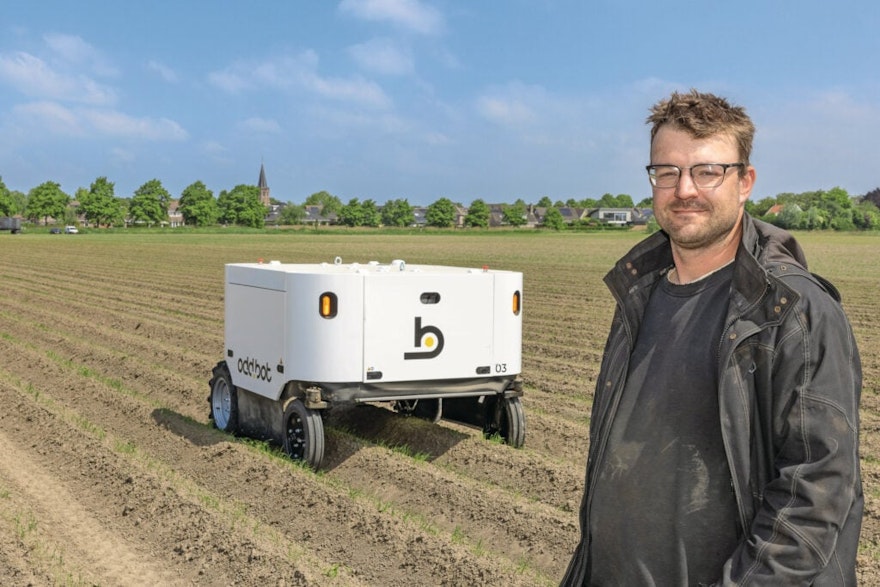What started as an experiment in 2024 has turned into a clear decision. Emiel van Hootegem, a biodynamic arable farmer from Kruiningen (Netherlands), joined a pilot program testing robotic weeders. Just a year later, two different machines roam his fields: the Maverick from Odd.Bot and the Tor from Trabotyx. Now, with two seasons of experience behind him, Emiel is ready to invest. In 2026, he plans to purchase his own weeding robot.
"You really need to see it, and more importantly, work with it. Only then do you realize what a robot like this can offer," Emiel explains. This is the story of a grower who turned doubt into insight and action.
Robotics on a Biodynamic Farm
Emiel runs Meulwaeter, a 140-hectare biodynamic farm in Zeeland, alongside his parents. They grow onions, carrots, parsnips, grains, legumes, and more, always with a focus on soil health and biodiversity.
Hand-weeding has long been a labor-intensive part of their operation. With permanent staff and seasonal workers hired through agencies, labor management is a constant challenge. As pressure on labor continues to grow, Emiel had already been looking for smarter alternatives.
Through the Interreg project "Smart Farming & Food Processing," he was introduced to robotic weeding. The project brought together farmers, tech companies, and researchers to test weed control robots in organic systems. Meulwaeter offered its fields as a test site for both the Maverick and the Tor.
Two Seasons of Testing: Maverick and Tor in Action
Spring 2024 marked a turning point: for the first time, a robot worked autonomously between Emiel’s onion rows. The Maverick used cameras and mechanical arms to remove weeds with pinpoint accuracy. Later that season, the Tor was also tested, using a different but complementary approach.
"It took some getting used to," Emiel admits. "You're used to being in full control. With a robot, you're trusting the system to do the work." Still, the Maverick quickly impressed. "It ran day and night, no breaks, no complaints. It brings a kind of peace to the farm. You just start it up, and it goes."
Of course, there are limits. Once the crop grows too tall and starts shading the weeds, the robot loses visibility and effectiveness. "That’s not a flaw, it’s just a matter of timing. You have to deploy it early enough."
Soil conditions also made a difference. Wet ground, uneven beds, or patchy crop emergence all impacted performance. "Those are factors you have to plan around."
Thinking Like a Robot: From Manual Labor to Strategic Timing
More than anything, the trial shifted Emiel’s mindset. Where he once scheduled weeding around available workers, he now thinks in terms of strategic moments: when is the crop at the right stage for the robot? How can I avoid backlogs without extra labor?
Using the Maverick also introduced data into the equation. "You get feedback, how many meters it covered, how effective it was, where it got stuck. It's like working in partnership with the machine."
Why Buy Now?
After two seasons of testing, Emiel is confident: the technology is ready for serious use. "Sure, there's room for improvement. But that’s true for people too. The robot is precise, reliable, and eases peak-season pressure. Most importantly, it gets the job done."
The financial logic is also clear. One robot can easily replace several workers per day. In an era of labor shortages and rising wages, that matters.
Equally important is the trust he’s developed in the supplier. "Odd.Bot listens, follows up, and really engages with us. That makes it easier to take the leap."
Not Replacing People
For Emiel, robotics isn’t about replacing labor, it’s about using it more wisely. "We’ll still do some hand-weeding. But if the robot handles the first pass, the rest is much more manageable."
His plan to purchase a weeding robot in 2026 isn’t driven by novelty, it’s a logical next step. "We tested it, we learned, and now we know what it brings to the table."
Want to See It for Yourself?
Emiel’s story shows that robotic weeding isn’t some far-off vision. It’s already happening, in real fields, with real results. With the right timing, the right crops, and a bit of courage, robots can make a lasting difference.
Curious what a weeding robot could do for your farm? Book a demo, or talk to a grower who's already tried it.
Source: Future Farming
Read full article here

